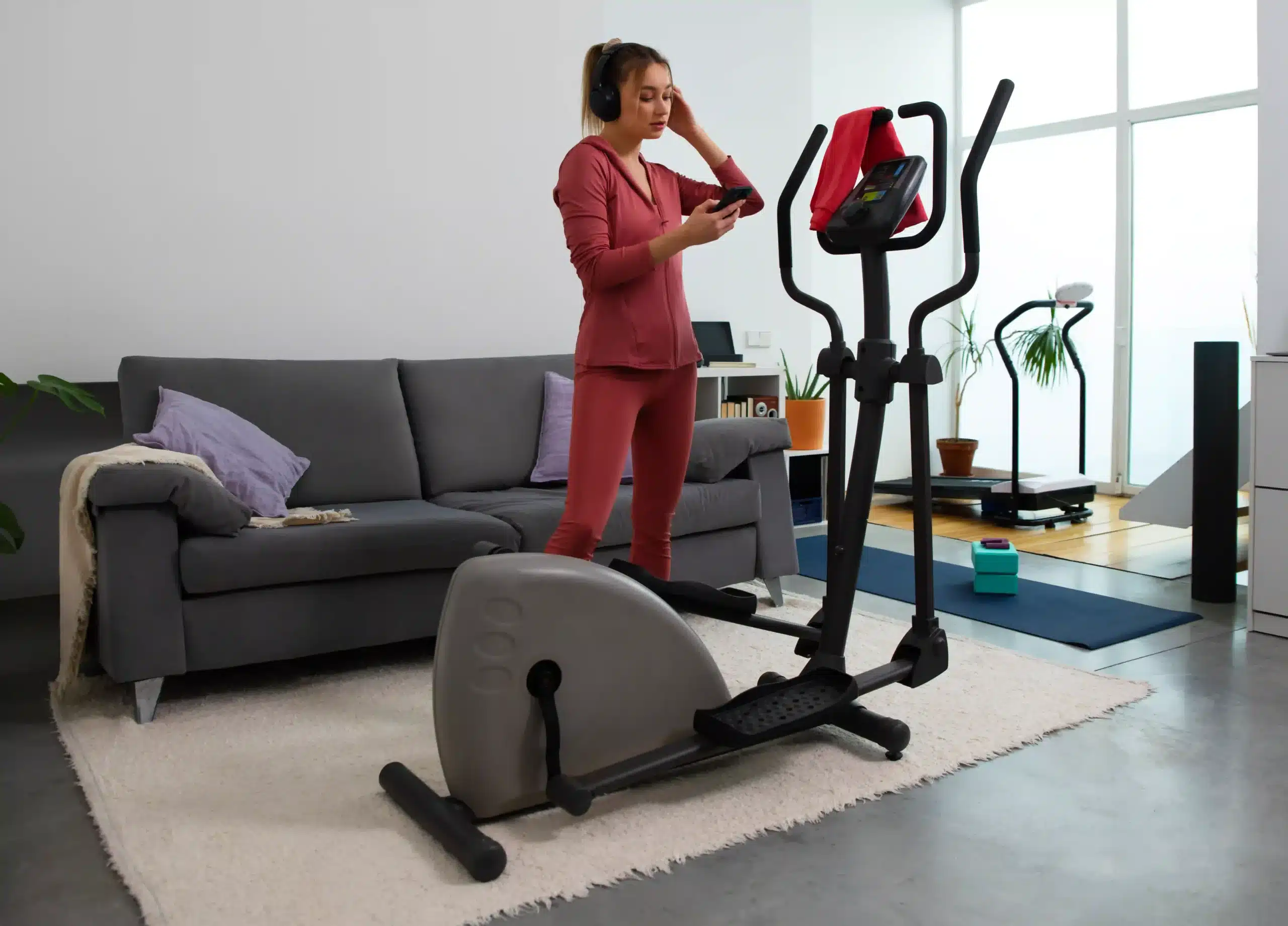
Moving an elliptical can be challenging. Ellipticals are big, heavy, and awkward to carry. They can cause injuries and damage to property if they aren’t moved properly. In this guide, you’ll learn how to move an elliptical properly and find suggestions about what equipment to use and safety measures to keep in mind.
Why It’s Important to Move an Elliptical Properly
Being overly confident in your ability to move an elliptical without the proper equipment, techniques, and assistance can result in the following consequences:
- Property Damage: Ellipticals typically weigh over 100 pounds. Moving an elliptical improperly carries a risk of damage to the elliptical itself and to the surrounding area. Bumping the elliptical against household surfaces can leave scuff marks on your flooring and also dent your walls and door frames, potentially reducing the resale value of the property.
- Injury: Lifting and shifting a heavy machine without the correct technique or proper equipment may lead to a strained back, a twisted ankle, or even broken toes if you drop the elliptical by accident. Using proper form and equipment decreases the risk of injury.
Equipment You’ll Need to Move an Elliptical
Before you start moving your elliptical machine, you’ll need to gather the right moving equipment to make the job easier and safer. This will include:
- Gloves: A good grip is essential when lifting and moving large items. Gloves protect your hands from pinches and cuts and keep you from losing your grip. Choose gloves that have reinforced palms and are made with breathable fabric so your hands don’t get too hot while moving the elliptical.
- Closed-toe shoes: Foot injuries when moving large, bulky objects are common. We recommend wearing closed-toe shoes with good support and a flat sole. For extra protection, you may want to wear steel-toe boots.
- Furniture sliders: Furniture sliders are small but effective tools that help reduce friction between the elliptical and the floor. They work best on hardwood, laminate, and tile floors.
- A dolly or hand truck: Dollies are flat platforms on four wheels, whereas hand trucks are L-shaped devices on two wheels. Generally speaking, dollies are better suited to moving heavy ellipticals; however, you can also strap your elliptical to a hand truck if needed.
- A screwdriver, Allen keys, and locking pliers: These tools will help you disassemble your elliptical if you don’t plan to move it in one piece.
- Packing materials: Many elliptical machines come with sensitive display screens, console wiring, and painted metal finishes. We recommend using moving blankets and bubble wrap to protect the appearance and functionality of your machine.
- Ratchet straps: Ratchet straps hold your elliptical down and keep it secure when it is being transported on a dolly or in a moving truck. Make sure to tighten the ratchet straps just enough to hold the elliptical down, but not so much that you over-compress the delicate components of the machine.
- Measuring tape: You’ll need a measuring tape to determine the dimensions of your machine to make sure it fits through the halls and doorways in your new house.
How to Move an Elliptical
Once you have all the tools and equipment you need, you’re ready to start the moving process. In this section, we’ll take you through the measuring, disassembly, transportation, and setup of an elliptical machine.
Take Measurements
Before doing anything, you should measure the height, width, and length of your elliptical. Next, measure all the passageways you will need to go through to see whether the machine will fit. If it won’t fit through the hallways and doorways in your new home, you will need to disassemble it before moving.
Create a Safe Pathway
If you plan to move your elliptical in one piece, you’ll need to clear a pathway for it.
- Remove obstacles: Clear all rugs, furniture, cords, and anything else you could trip over while moving the elliptical. Make sure pets and kids are out of the way to prevent accidental injury.
- Protect the floors and walls: Use moving pads or thick towels to cover the floors and walls in tighter spaces to avoid scuff marks and dents.
Disassemble the Elliptical (If Needed)
- Unplug the elliptical: You should never disassemble an elliptical while it is plugged into an electrical outlet. Before you start removing components, make sure to unplug it.
- Disassemble the elliptical: Remove all detachable parts, which may include the arms and pedals. Be sure to take a picture of each disassembly step to make reassembly easier once you’re settled in your new home.
- Label parts for easy reassembly: Place screws, nuts, and bolts in labeled plastic bags and tape them securely to the corresponding parts. This will help you avoid confusion when it’s time to reassemble the device.
Move the Elliptical
- Use proper lifting technique: If you’re lifting the elliptical without the help of a dolly or handtruck, you’ll need a partner. To avoid muscle strain, make sure to bend your knees and lift with your legs, not your back. Never twist while lifting, and communicate clearly with your helper so you lift in sync.
- Use the right tools: A dolly or hand truck will take the strain off your body and can be used if you’re moving the elliptical on your own. You can also use furniture sliders to facilitate the moving process. Felt sliders are excellent for hardwood and tile floors, while hard plastic sliders are better for carpeted floors.
- Be careful on stairs: When moving an elliptical down stairs, lead with the heavier end. One person should support the lower end of the machine while another holds the higher end. Go slowly, and do not rush this step.
- Navigate tight spaces with care: When turning a corner or trying to fit through a narrow doorway, you may need to tilt or rotate the elliptical slightly. A dolly under the elliptical will help you navigate tight turns and doorways. If it makes the job easier, you can temporarily remove doors from their hinges and add cardboard padding to tight corners to avoid dents.
Load the Elliptical on Your Moving Truck
- Use a ramp or lift gate: Using a ramp or lift gate will make it easier to load the elliptical onto the vehicle. Check that the surface of the ramp or lift gate is dry and that one person is always spotting you during the lift. Always ensure someone has their hands on the item at all times.
- Secure the elliptical: After loading the elliptical onto the moving truck, use ratchet straps or heavy-duty rope to tie the unit down and secure the ends of the straps or rope to the anchor points inside the truck. You should also wrap the elliptical in moving blankets to protect it from scratches and dents during transit.
Unload the Elliptical and Set It Up
- Unload the elliptical from the truck: With the help of another person, carefully roll the elliptical down the loading ramp. Hold it tightly and communicate with your helper at all times. Be mindful of bottoming out at the end of the ramp when unloading.
- Place the elliptical in its new location: Place the elliptical on an even surface near an electrical outlet in the room you plan to work out in.
- Reassemble the elliptical if disassembled: Reattach the detached components to the elliptical, following the instructions in your user manual if applicable.
- Plug the elliptical back in: Once reassembled and ready for use, plug the elliptical in and make sure its electrical cable doesn’t pose a tripping hazard.
Test the Elliptical
Run a test cycle on your machine before you put it to full use. Make sure the screen turns on, the resistance settings still work, and the pedals move without catching. Listen for any unusual sounds or indications of instability. If any bolts or bushings are loose, tighten them as specified in the instruction manual.
Serenity Moving Services Can Help!
Moving an elliptical machine on your own can be time-consuming and physically demanding. That’s why many homeowners opt for professional moving services instead of going the DIY route. At Serenity Moving Services, our team carefully handles heavy pieces of equipment, so you don’t have to worry about injuries or property damage. We use specialized equipment, including appliance hand trucks and ratchet straps, to move ellipticals and other heavy items safely. Whether you’re moving down the street or to another state, we can handle the logistics while you focus on settling into your new home. Call us today for a free quote!
Frequently Asked Questions (FAQs)
Measure the elliptical and the doorframe beforehand; if the elliptical doesn’t fit, try removing large components, like the arms and pedals, to reduce its size. You can also remove doors from their hinges to increase clearance.
If your elliptical is too heavy to lift, use a dolly, sliders, or a professional service to move it. If you experience pain or extreme muscle strain when attempting to move the unit, stop and try again with a partner or two.






